Web-site restrictions
ACAT will be moving to a new web site on Thursday, 10th April.
In preparation, from Friday, 4th April this old web site will not let members renew their membership, and any other changes members make, e.g. their personal details, will get ‘lost in the move’.
Urgent membership renewals should instead be done by contacting Alison Marfell.
Beyond State Shifts - Metashifts
Nehmad, A., 1997. Beyond State Shifts - Metashifts. Reformulation, ACAT News Summer, p.x.
CAT is still evolving. The way we draw diagrams has changed several times over the years. Meanwhile, however, our understanding of Borderline Personalities, and the main tasks of therapy with such clients, has been pretty constant for at least 10 years:
The range of reciprocal role procedures (RRPs) derived from different early interactions are slowly integrated to provide complex RRPs for relating to whole others, but in adverse childhood's (deprived, abused, not separated, etc.) this integration may be incomplete. (...) Inner and outer world relationships are to some extent not clearly differentiated. and one or other pole of an inner I - me RRP may be located in another person who will be selected for, or induced into, playing the appropriate role: this is Projective Identification.
"(...) An important aspect of therapy is the therapist's non-collusion with these invitations and his ability to gather and integrate the hitherto split part - RRPs." Tony Ryle, Workshop Handout, March 1987.
By 1988, the first Sequential Diagrammatic Reformulation (SDR) appeared 1. It included Stable and Transient States, which helped to make sense of the swift and often apparently unprovoked shifts of very fragmented borderline personalities.
By 1991, diagrams essentially similar to those we use today had appeared 2 . These include more than two Self-states (see Figure 1). They have been used by most CAT therapists treating Borderline Personalities. Meanwhile, clients with Relatively Well integrated Personalities (RWIPs) had Diagrams that looked like that in figure 2. The emphasis for many continued to be on naming the Core Pain, contained in the "internal child" role at the bottom of the diagram. Procedures were seen as expressing, or avoiding, key Reciprocal Roles contained in the "Core State" (internal Parent - internal Child).
Ideally caring
Always available
Undemanding
Ideally cared for
Secure, blissful
Rejecting
Cruel
Arbitrary
Authoritarian
You are not OK
You and your
needs don't matter
Crushed
Victim
Empty
Unloved
Unmanageable pain
I'm not OK
Absent
Unavailable
Shut out
Blank
Numb
Withdrawn
Alone
Blaming
Demanding
Conditional
You're only OK If...
Insecure
(Fear of being) Inadequate
I'm only OK If...
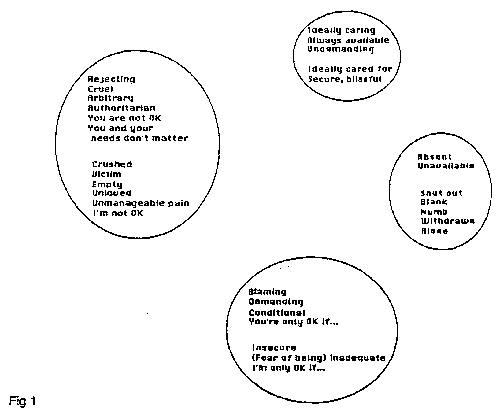
Fig 1
I.P. Manipulative Two-faced Critical, Rejecting Neglecting "Always right" Total approval or total disapproval
I.C.
Rejected, Neglected, Hurt, Angry
Unloved and unloveable
Empty, confused
Poor self-image Difficulty making sense of the
world Difficulty trusting
T.P.P.
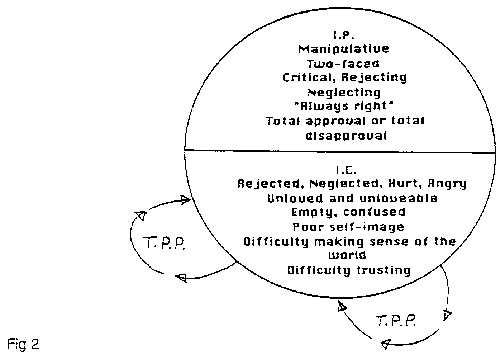
Fig 2
However, Tony Ryle and most CAT therapists came to realise that diagrams which showed three or more sets of Reciprocal Roles, each with its own Procedures, were a more accurate and useful representation not only for fragmented, self-harming, substance-abusing, Borderline Personalities, but also for "nice normal" people with steady jobs, married with two children, with no features of DSM-Borderline Personality Disorder (BPD). Many of these people have fragmented inner worlds - or at any rate fragmented diagrams.
The continuity between RWIPs and Poorly Integrated Personalities (PIPs) (both borderlines and narcissists) has been increasingly acknowledged. In CAT terms there is a continuum between, Integration and Fragmentation. We are all dissociated, or fragmented, or split, to some degree. The task of therapy is not simply to find exits from Target Problem Procedures and to make these habitual, but in fact to integrate the personality. Not only for the very fragmented, but even for RWIPs.
Let's take the example of a relatively well-integrated woman (with no DSM criteria for BPD) with the placation trap and difficulty asking others to meet her needs. She may need help acknowledging her own neediness and vulnerability, and "building this into" her self-image and "self-map", so that her behaviour changes accordingly. Should we speak of repression of her needy, greedy (and angry) bits? Or dissociation from them? Technically (in terms of psychoanalytic theory), Impulses - especially Id derived - are repressed. So if we dissociate from a self-state which contains forbidden impulses, we are simultaneously repressing . I feel that it is no longer useful to speak of repression or dissociation. I think CAT provides a kind of synthesis of both concepts: the concept of FRAGMENTATION includes both dissociation and repression. The point is that for this woman, when she is in her predominant coping mode, she is out of touch with, or split off from the needy, greedy, vulnerable (and resentful) aspects of her self. When she gets depressed, she gets in touch with these aspects, but loses touch with her coping self. An important task of therapy is to connect these aspects, so that even when in coping mode she can connect to her own vulnerability; and when depressed and hopeless she can remember that she is also a strong coper.
I'd like to show you an interesting way of representing degrees of dissociation/integration. This comes from a Brief Therapist, Bill O'Hanlon, who had never heard of CAT, but has come up with a diagrammatic representation which I feel we could usefully adopt when teaching CAT ( see Figure 3). The top of the picture represents the product of a "typical" (we might say "good enough") family: the infant will develop into a person who is relatively well integrated, i.e. in (partial) touch with all aspects of himself. He will also have clear boundaries in relation to the rest of the world - he will be fairly clear on what is "inner" and what is "outer". The middle of the picture depicts the product of a traumatic upbringing: a person who is split off from aspects of themselves, and who has not developed clarity about inner world and outer world - so there is great scope for projection and projective identification. The bottom of the picture represents the task of therapy - it looks like an illustration for the task of therapy as described by Tony Ryle:
"Therapy must build a bridge across the split and relies on contacting a central island of self able to cooperate in this task" Workshop Handout, March 1987.
Integrating Dissociative Aspects of Self in the Aftereffects of Trauma
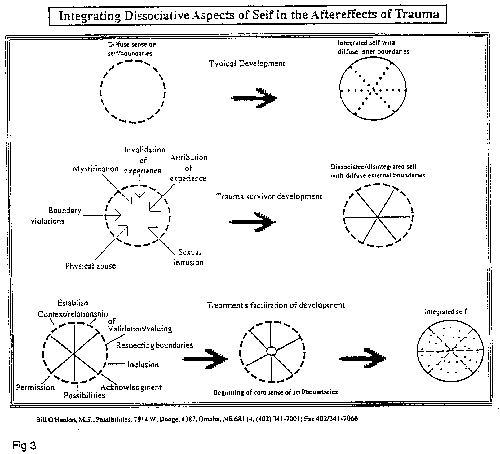
Fig 3
Coming back to CAT diagrams: most CAT therapists now produce a Sequential Diagrammatic Reformulation (SDR) similar to that in Figure 1. We now call each set of Reciprocal Roles a "Self-State". Each pole of a Self-State is known as a State of Mind. Each State of Mind (or Role) includes affect, communication, perception, behaviour, and expectations. I would add that it includes memories, not always available to the whole person. This is seen most clearly in very fragmented people. It does not only include traumatic memories, but quite ordinary ones. For example, a client tells you in Session One "My father was cruel and tyrannical". You then include this phrase in the Reformulation, and they say "I don't like the way you describe my father; he just did what he had to, in difficult circumstances". They have quite forgotten that they used those very words to you, two or three weeks ago.
The current CAT understanding is that Target Problem Procedures (TPPs) come from a particular Self-State. The perceived limitations on what's possible (dilemmas), or the perceived prohibition of success (snag) or the negative self-beliefs which give rise to traps, often belong to one Self-state, or even to one State of Mind. If this Self-state can be more in touch with the rest of the personality, the intensity, frequency and "inevitability" of that TPP will be lessened. Different parts of the self can "talk to" each other, "moderate and soften" each other, and so on. A useful internal dialogue between the healthier self and the more maladaptive self-states can ensue.
Honest, Kind, Hopeful, Insightful Able and willing to change Flexible, empathic Sense of humour Able to reflect and have overview of self
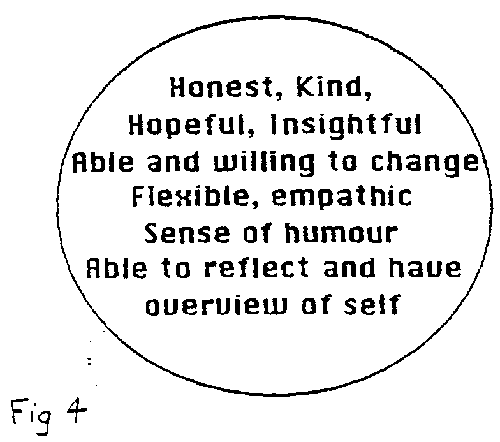
Fig. 4
There has been a long-running debate within ACAT about whether SDRs should contain the healthy aspects. I am convinced that it is helpful to do so (it reduces clients' pessimism about themselves); it is also more accurate to do so. If clients sometimes operate in a healthier way, it belongs on the SDR. Why on earth leave it out? There are two ways in which the healthier parts of the self can be represented on the diagram. One way is to add a "healthy islandleye-land/I-land", which contains the Healthy self-state. Figure 4 shows the "healthy island" of the client in Figure 1.
The other way is to include the healthy aspects of each State of Mind. For example, the client in Figure 2 operated in an extremely split way; each half was almost totally disconnected from the other. She was either a "Good Child" (perfect crushed placator) or a Rebellious "Sad Child." Figure 5 shows how this was represented on her SDR (the Procedural loops have been left out). The point is not only that neither way of operating was healthy, but that neither was entirely unhealthy. Each of the States of Mind contained healthy resources.
I.P. Manipulative Two-faced Critical, Rejecting Neglecting "Always right" Total approval or total disapproual
I.C.
Rejected, Neglected, Hurt, Angry
Unloved and unlovable
Empty, Confused
Poor self-image
Difficulty making sense of the world
Difficulty trusting
Rebellious "Bad Child"
Self-care Don't need to be perfect
Assertive
"Street-wise"
(insight into others'
motiuation and faults)
Compliant "Good Child" (Perfect, crushed placatory)
Kind, Caring
Generous
Tolerant
Thoughtful
Loving
Well-organised
Trusting
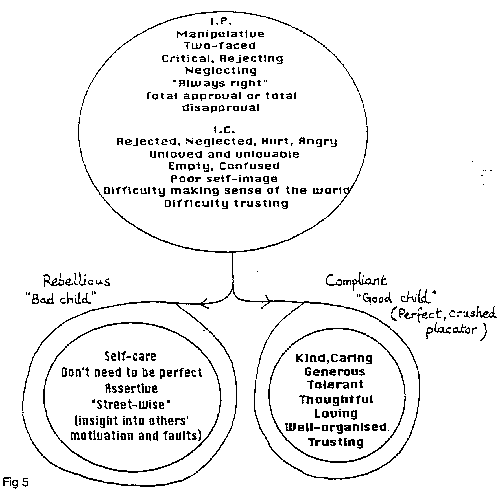
Fig 5
Which form I use to depict the healthy aspects depends on the client, on the rest of the SOR, etc. There is no rule. Diagrams are only heuristic, after all.
Tony Ryle's recent article in the British Journal of Psychiatry 3 introduces an interesting and very useful hierarchy of procedures. Clearly, Tony is using the word Procedure, in this case, to include healthy procedures; and not simply Problem Procedures. Level 1 are the RRPs involved in self management and in relationship to other people - it includes both healthy, adaptive, and unhealthy (inappropriate, maladaptive) procedures. We could say that the typical "pathological" SDR exemplified by Figure 1 contains only Level 1 procedures. Level 2 are higher order, integrating procedures. They allow us to act appropriately , i.e. to choose a procedure from our repertoire which is reasonably appropriate to the context, the person we are interacting with, etc. Level 3 is the basis of consciousness, self reflection, and the sense of self. I think they allow us (in conjunction with Level 2) to act flexibly - to change direction if our first choice of procedure is not successful, etc. Level 2 and Level 3 should develop during therapy. I think I would see Level 2 and level 3 in a positive feedback loop with each other. They would be contained in the Healthy Island/Eye-land/I-land of the SDR - i.e. the healthy self which not only initiates its own healthy procedures, but "intervenes" when unhealthy procedures might take place; the bit that can tell the rest of the person, "hang on; don't fall for it: no, you don't have to placate this time", or who stops us acting according to our destructive impulses. When that healthy self (with its higher order procedures) is weak or faulty, we are at the mercy of unhealthier aspects of ourselves.
So RWIPs and PIPS are on a continuum. We could think about quantifying how dissociated, or split, or fragmented, each person is. I don't yet have concrete suggestions about how to do it - perhaps a clever CAT person will design a questionnaire. In therapy, the Degree of Integration should increase, and it is useful to find a language with which to express this to the client. We could represent it by speaking of (and/or drawing) "bridges" between the different States of Mind. If we did not need to represent the Procedures on the SDR, if we just drew in the Self-States, we could represent the varying degrees of integration according to the separation between the various Self-States. Thus, Figure 6 represents a Relatively Well integrated Personality, and Figure 7 represents a Poorly Integrated Personality.

Fig 6 and Fig 7
In fact, however, things are rather more complicated. Firstly, even in a successful therapy, there is not a smooth linear increase in integration, but ups and downs - "METASHIFTS" - in which the person does not simply move from one Self- State to another, but from one degree of integration to another. They can zig, and zag. Also, the degree of integration changes, in response to other things - not just therapy. One obvious factor is age. The prevalence of Borderline Personality Disorder decreases with age. At some point, many borderlines become more sure of their identity, more stable, their experience. less discontinuous. Of course not in every case - but in many cases. Adolescence is the Borderline Age par excellence.
The "stages" of mourning are often not stages at all - people may veer wildly from denial to anger, to blaming the doctor, to idealisation of the past, to blaming themselves, to numbness, then back to denial and so on. People temporarily behave in a "poorly integrated" manner 4
There are several other factors which may be important. Constancy and familiarity tend to integrate people; especially a steady job (even if not a particularly good one), and stable relationships (even if not very happy). On the other hand, forced unemployment, or the break up of a relationship, or the death of a close relative, destabilises people.
I began to reflect on an individual's varying degrees of integration a few years ago. The idea of "Metashifts" came about quite recently, when supervising the therapy of a client whom I'll refer to as "Jenny Lomax". She clearly had Borderline Personality Disorder. She described being 'two people'', "Jenny" and "Lomax". "Jenny" was feminine, unassertive, a fragile and vulnerable victim, but also in touch with feelings, and able to be sad. "Lomax" was masculine, assertive, aggressive, confident and brash. She described how for many years she had tried to suppress "Jenny"; however. she had realised - even before starting CAT - that what she needed was to bring the two together, because "Jenny" was also a valuable part of herself. So she came to therapy, well on the way to integration. Initially she was guarded, and mostly in "Lomax" mode, but this gradually relaxed. There was a good therapeutic alliance, and much useful work took place. The therapist was able to address the Reformulation to "Dear Jenny/Lomax". She responded well to the Prose Reformulation and Diagram. She became more thoughtful, more flexible, more self-reflective, less obsessed with thoughts of the past and of revenge. Then, at session eight. things deteriorated quite suddenly. She became very cut off from her feelings. and from the therapist, who felt shut out and unable to get through. Sometimes "Lomax" was back; sometimes an impenetrable blank wall. "Jenny" disappeared altogether for about four sessions. We could represent this simply by using a "Level 1" SDR, and mapping out which state of mind she was in. However, the most striking aspect of the change was that her degree of integration was markedly different. She was the first client for whom we drew a Metashift diagram in supervision, for the benefit of the therapist and the group (see Figure 8). I would suggest that this is a useful way (for both therapist and client) of conceptualising the zigs and zags of some therapies.

Fig 8
I want to move on to look at therapists themselves. It seems to me that one of the things clients - especially Borderline Clients - do to us, is to recruit us into a lower level of integration. When we suddenly feel confused and de-skilled, you could say that they recruit us into a "confused" state of mind. I think it is more accurate to say that they induce a metashift in us, so that we become cut off from aspects of ourselves such as our professional skill, personal self-confidence, etc.
A few years ago I did some sessions at a Day Unit in Hackney called The Junction. After an introductory workshop on CAT, I visited the unit for three afternoons, at two-monthly intervals. We made diagrams of the most confusing and difficult clients. It became clear that they were managing to enact a different self-state with each member of staff, so that Nurse A was compassionate and protective, Nurse B blanked off and bored, Nurse C cross and impatient etc. Sometimes this created conflict between members of staff; more often it simply meant that staff continued to collude with familiar roles, but could not provide an integrating function for the client. I explained this in traditional CAT terms, i.e. in terms of their "level 1" SOR , with each staff member recruited into one Pole. This was enough for useful change to happen in staff behaviour and understanding. I think that today I would conceptualise things a bit differently. Yes, each nurse was being recruited into one reciprocal role. But also, each nurse was being recruited into a "less integrated" place. Each of them was behaving as if they could only stay in touch with one of their own self- states. This helps to explain why all members of staff felt uncomfortable when we described what had been happening. Obviously those who had been cold and rejecting felt embarrassed; rather less obviously, the ones who were "caring and compassionate" felt just as uncomfortable. I would argue that the embarrassment was due to their having lost touch with their Level 2 and Level 3 Procedures - and with aspects of themselves other than pure "caring and compassion".
We tend to respond to, and mirror, the degree of integration of the person we are with. The less integrated they are, they greater the "downward pressure" on our own degree of integration. In terms of Tony Ryle's Hierarchy of Procedures, Level 2 procedures become "disabled" or "put out of commission" by certain triggers, including the presence of Poorly Integrated Personalities. Of course, we each have our own personal triggers as well! One's own children are a pretty reliable trigger. They are very good at "winding you up". You lose your temper, or shout, or say things you wish you hadn't said ... Fortunately, there are two sides to this coin, and our own Degree of Integration - which is usually reasonably high, especially when we are being "The Therapist", will exert a beneficial pressure on the degree of integration of our clients. Our current CAT understanding is that we help our clients to integrate by describing what they are doing, and by failing to be recruited into the roles they try to recruit us into. I would argue that we could also say that we help them to integrate by remaining relatively well integrated in spite of their provocations - i.e. in spite of their "downward pressure" on our level of integration. Most people in the outside world respond to poorly integrated personalities in kind - i.e. by behaving in poorly integrated ways (shouting back, coldly rejecting, etc.). We. as therapists who understand what is going on. are usually able to "keep an overview" and stay in one piece. In terms of Tony Ryle's Hierarchy of Procedures. Level 2 and Level 3 remain healthy and functioning. Sometimes, of course, this doesn't happen, and clients recruit us into an unhealthy place (and into a lower level of integration). When this happens, if we are able to reflect on it later during that session, or at a later session, we can feed it back to the client, thus modelling not only a healthy Level 1 RRP but also a Level 3 procedure.
If we remain un-integrated and un-reflective about what has happened (in other words, if our level 2 and level 3 procedures have not recovered - at least in relation to this client), we will not be able to use this for our client's benefit. However, we usually turn up to supervision in this less integrated state; "parallel process" then takes place. In other words, the partial. and dissociated RRPs enacted between therapist and client are re-enacted in the supervision group. Hopefully the Supervisor and/or other group members can then act as our external "Level 2" and "Level 3". They allow us to reflect on what has happened. and to choose from a repertoire of responses; in other words they act to increase our level of integration, and our ability to reflect. Thus restored, we can carry on the therapy, continuing to provide an "external" Level 2 and Level 3 for our client.
Notes
1. See the 20-page typed handout 'An Introduction to Cognitive-Analytic Therapy (CAT)', Anthony Ryle, 1986 (Revised 1988), p 12. This diagram is also included in 'Cognitive-Analytic Therapy: Active Participation in Change', A. Ryle, John Wiley, 1990, p 110.
2. See the 10-page typed handout 'Reformulation' (Revised 1991), A. Ryle.
3. "For example, a child at breakfast might effortlessly combine, by means of Level 2 functions, three Level I procedures: (a) silent obedience to an irritable father, (b) nurturant affection to a depressed mother, and (c) cheerful mutuality with a sister". A. Ryle, 'The Structure and development of borderline personality disorder: a proposed model', British Journal of Psychiatry 1997, 170, p. 82
4. I first realised this when an experienced CAT therapist (and I as supervisor) misdiagnosed a client as "borderline" when in fact she was going through "stages" of grief.
Acknowledgements
I would like to thank Tony Ryle and Maria Pelengaris for their contributions to this paper, and Bill O'Hanlon for allowing me to use his diagram (figure 3).
Annie Nehmad


Full Reference
Nehmad, A., 1997. Beyond State Shifts - Metashifts. Reformulation, ACAT News Summer, p.x.Search the Bibliography
Type in your search terms. If you want to search for results that match ALL of your keywords you can list them with commas between them; e.g., "borderline,adolescent", which will bring back results that have BOTH keywords mentioned in the title or author data.
Related Articles
Some reflections on the Malaga International CAT Conference "Mental health in a changing world"
Maria-Anne Bernard-Arbuz, 2013. Some reflections on the Malaga International CAT Conference "Mental health in a changing world". Reformulation, Winter, p.50.
Diagrammatic Psychotherapy File
Dunn, M., 2002. Diagrammatic Psychotherapy File. Reformulation, Spring, p.17.
CAT For The Elderly
Harbour, K. and Nehmad, A., 1995. CAT For The Elderly. Reformulation, ACAT News Winter, p.x.
What's it like to have Cognitive Analytic Therapy?
Sloper, J., 2002. What's it like to have Cognitive Analytic Therapy?. Reformulation, ACAT News Spring, p.x.
Working With Sex Offenders When You Think Like a CAT Person
Bermingham, D., 1998. Working With Sex Offenders When You Think Like a CAT Person. Reformulation, ACAT News Spring, p.x.
Other Articles in the Same Issue
Beyond State Shifts - Metashifts
Nehmad, A., 1997. Beyond State Shifts - Metashifts. Reformulation, ACAT News Summer, p.x.
Outcome of Cognitive Analytic Therapy
Ford, T.J., Roberts, J. and Pound, A., 1997. Outcome of Cognitive Analytic Therapy. Reformulation, ACAT News Summer, p.x.
Help
This site has recently been updated to be Mobile Friendly. We are working through the pages to check everything is working properly. If you spot a problem please email support@acat.me.uk and we'll look into it. Thank you.
